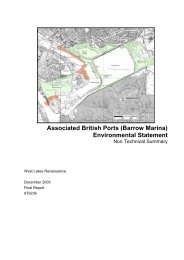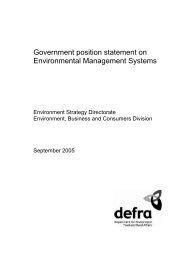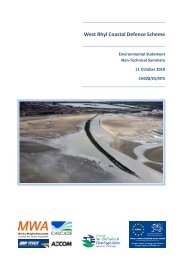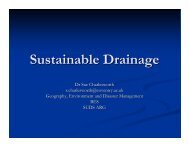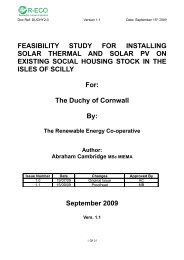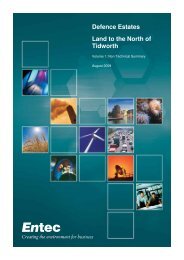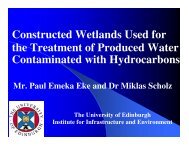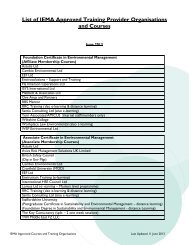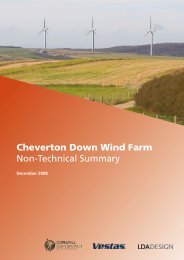Environment Law Bulletin - Institute of Environmental Management ...
Environment Law Bulletin - Institute of Environmental Management ...
Environment Law Bulletin - Institute of Environmental Management ...
Create successful ePaper yourself
Turn your PDF publications into a flip-book with our unique Google optimized e-Paper software.
SECTION 6Transport and labelling<strong>of</strong> waste andhazardous substancesUnited KingdomCHIPThe HSE has launched a website giving informationon the Chemicals Hazard Informationand Packaging for Supply (CHIP Regulations2002). The Regulations affect all chemicalsuppliers and are an attempt to ensure thatthose supplied receive the relevant informationrequired to protect themselves, othersand the environment. Suppliers have to identifyhazards such as flammability and toxicity,which together with advice on safe use, hasto be passed on to users, usually throughpackaging labels and safety datasheets. Thewebsite covers an introduction to theRegulations, recent changes and publications,as well as information relating to severalother aspects <strong>of</strong> CHIP 3 which consolidatesand extends the previous Regulations andcame into force on 24 July 2002.(HSE, January 2003)Carriage <strong>of</strong> dangerous goodsThe HSE has announced that the preparation <strong>of</strong>draft Regulations on the Carriage <strong>of</strong> DangerousGoods by Road and Rail is being delayed due tocomplex legal issues. It has stated that it expectsa document to be published in June 2003 for athree-month consultative period. Therefore, it isunlikely that the Regulations will come into forcebefore 1 March 2004. The new Regulations willimplement the 2001 and 2003 texts <strong>of</strong> RID andADR. Tank manufacturers will not be legallyrequired to manufacture new tanks for use onthe domestic market to approved RID or ADRstandards until the Regulations are in force,although the new standards may be used ifmanufacturers wished to do so. The newRegulations will also complete the implementation<strong>of</strong> the Transportable Pressure EquipmentDirective (99/36/EC).(Department for Transport, 7 February 2003)A draft statutory instrument intended toamend provisions in existing Carriage <strong>of</strong>Dangerous Goods Regulations relating tothe construction, inspection, testing anduse <strong>of</strong> tanks and pressure receptacles hasbeen issued for consultation. This isintended as an interim measure to ensurethere is no gap between existing requirementswhich expire on 1 July 2003 whenrequirements fully implementing equivalentprovisions in RID, ADR and theTransportable Pressure Equipment Directiveare due to be put into place in a single set<strong>of</strong> consolidated regulations (see above). Asa result, existing requirements will continueto apply until the draft Regulations comeinto force. The amending Regulations,therefore, defer the date when the existingrequirements expire until the end <strong>of</strong> 2004.Responses to the consultation should havereached HSE by 2 April 2003.European UnionImport and export(HSE, 20 February 2003)An EU Regulation No 304/2003 concerningthe export and import <strong>of</strong> dangerous chemicalshas entered into force after beingpublished in the Official Journal. It repealsand replaces Regulation (EEC) No 2455/92and implements the Rotterdam Conventionon Prior Informed Consent (PIC) for trade inhazardous chemicals and pesticides. Underthe new Regulation, importers have toexplicitly consent to receiving chemicals thatare banned or severely restricted in the EU.Those that are banned or severely restrictedfor consumer use will continue to form aseparate category and articles containingchemicals that could be released during useor disposal have to be notified for export.Chemicals not likely to affect health or theenvironment in quantities <strong>of</strong> not more than10 kilograms are exempt. The Commissionhas to review the chemicals listed annually.Gasoline, which contains benzene, is alsoexempt from notification requirements.(OJ L 63, 6 March 2003)“The new Regulations will implement the 2001 and2003 texts <strong>of</strong> RID and ADR.”InternationalRotterdam ConventionThe UN Food and Agricultural Organisation(FAO) has called for several substances tobe added to the PIC procedure under theRotterdam Convention. The substancesinclude five additional forms <strong>of</strong> potentiallycarcinogenic asbestos; the pesticidesDNOC, parathion and Benomyl-thiramcarb<strong>of</strong>uranmixture; and the petrol additivestetraethyl and tetramethyl lead. The recommendationswill be discussed by theinter-government negotiating committee <strong>of</strong>the Rotterdam Convention on priorinformed consent, in November 2003. Ifadopted then these chemicals will becomesubject to PIC.(UN News, 11 March 2003)27<strong>Environment</strong> <strong>Law</strong> <strong>Bulletin</strong>April 2003



